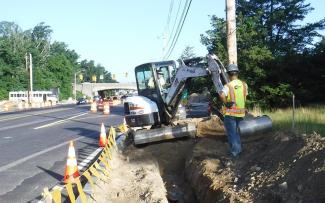Roadway Safety
What Do We Measure?
State Departments of Transportation (DOTs) must set annual targets for five safety-related performance measures, with the goal of achieving a significant reduction in traffic fatalities and serious injuries on all public roads. State DOTs report baseline values, targets, and progress toward reducing the number and rate of fatalities, the number and rate of serious injuries, and the number of non-motorized fatalities and serious injuries to FHWA in an annual safety report. MPOs may either establish quantitative targets for their metropolitan planning area or agree to adopt the statewide targets.
FHWA requires the DOTs and MPOs to establish safety targets on an annual basis for:

- Number of Fatalities: The total number of persons suffering fatal injuries in a motor vehicle crash during a calendar year.
- Rate of Fatalities: The ratio of total number of fatalities to the number of vehicle miles traveled (VMT, in 100 Million VMT) in a calendar year.
- Number of Serious Injuries: The total number of persons suffering at least one serious injury in a motor vehicle crash during a calendar year.
- Rate of Serious Injuries: The ratio of total number of serious injuries to the number of VMT (in 100 Million VMT) in a calendar year.
- Number of Non-motorized Fatalities and Non-motorized Serious Injuries: The combined total number of non-motorized fatalities and non-motorized serious injuries involving a motor vehicle during a calendar year.
Measures are for all public roads regardless of functional classification or ownership and each target is based on a five-year rolling average, which is the average of five individual, consecutive points of data.
What are the Targets?
The Rhode Island Department of Transportation (RIDOT) plans and programs projects that contribute toward meeting or exceeding statewide roadway safety targets in Rhode Island.
How Are We Doing?
RIDOT reports on behalf of the State of Rhode Island, baseline values, targets, and progress toward meeting the targets to FHWA in an annual safety report. FHWA will determine whether a state has met or made significant progress toward its safety performance targets. A state is considered to have met or made significant progress when at least four out of the five safety performance targets are met or the actual outcome for the safety performance target is better than baseline performance.
Meeting a Target
If the actual outcome for a performance measure is equal to or less than the target, the target has been met.
Better than Baseline
If a state has not met a target, FHWA will determine if the actual outcome for the target is better than the baseline performance for that target. The baseline performance is the five-year rolling average for the target ending the year prior to the establishment of the state's target.
If a state has not met or made significant progress toward meeting its targets, the state must comply with the provisions set forth in 23 USC 148(i) for the subsequent fiscal year. The state shall:
- Use obligation authority equal to the Highway Safety Improvement Program (HSIP) apportionment for the year prior to the target year, only for HSIP projects
- Submit an HSIP Implementation Plan that describes actions the state will take to meet or make significant progress toward meeting its targets. The HSIP Implementation Plan should guide the state's project decisions so that the combined 148(i) provisions lead to the state meeting or making significant progress toward meeting its safety performance targets in subsequent years.
